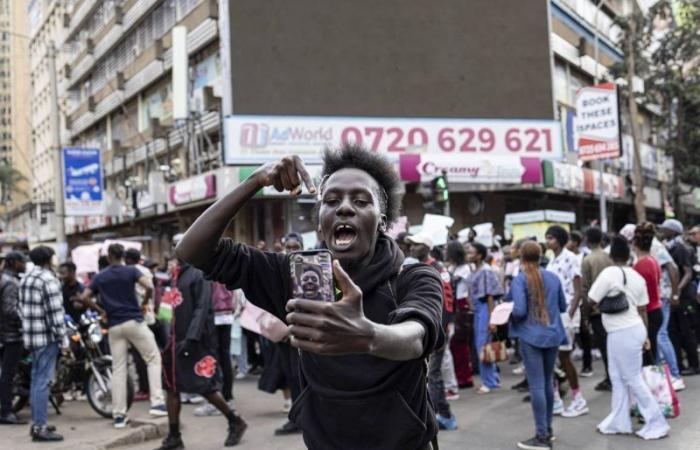At least one person was killed Tuesday during an anti-government protest in Kenya that turned into chaos in the capital Nairobi after demonstrators broke through police barriers and entered Parliament.
The NGO Kenya Human Rights Commission (KHCR) claimed to have seen the police “shoot four demonstrators, (…) killing one of them”, in a press release on X.
AFP journalists present on site saw three inanimate people, lying in pools of blood, near Parliament, where a building was briefly on fire.
After a few dozen minutes, the police regained control of the Parliament grounds. Television images showed ransacked rooms, overturned tables, broken windows and smoking furniture strewn across gardens.
Three army trucks brought reinforcements to secure the area around parliament, where dozens of demonstrators were facing police forces, AFP journalists noted.
A few hundred meters from parliament, police used a water cannon to put out a fire in the Nairobi governor’s offices, according to images broadcast by Citizen TV.
A little earlier, an official from Amnesty International Kenya, Irungu Houghton, reported in a statement to AFP that there were “numerous injuries”, denouncing the “increasing use of live ammunition by the police” during this demonstration.
Tension gradually rose on Tuesday in the central business district (CBD) of Nairobi where the third demonstration in eight days by a movement called “Occupy Parliament” opposed to the 2024-25 draft budget was held. which provides for the introduction of new taxes.
The first clashes broke out around midday after demonstrators advanced into an area housing several official buildings (Parliament, Supreme Court, Nairobi town hall, etc.), before the demonstrators managed to enter the precincts of the Parliament, where deputies had just approved amendments to the text, which must be voted on by June 30.
” Afraid of nothing ”
Other demonstrations were held in several other cities in the country, notably in the opposition strongholds of Mombasa (east) and Kisumu (west), as well as in Eldoret (west), a large city in the Rift Valley, President William Ruto’s home region, Nyeri (southwest) and Nakuru (central).
The “Occupy Parliament” movement was launched on social networks shortly after the presentation to Parliament on June 13 of the 2024-2025 draft budget providing for the introduction of new taxes, including a 16% VAT on bread and an annual tax. 2.5% on private vehicles.
For the government, taxes are necessary to restore room for maneuver to the country, which is heavily in debt.
After the start of protests, the government announced on June 18 that it was withdrawing most of the measures, but the demonstrators continued their movement, demanding the complete withdrawal of the text. They denounce a sleight of hand by the government which plans to compensate for the withdrawal of certain tax measures by others, in particular a 50% increase in fuel taxes.
Initially led by “Generation Z” (young people born after 1997), the movement transformed into a broader challenge to the policies of President Ruto, who said he was ready to dialogue on Sunday.
Moody Kimwele, 41, came with his 15-year-old son to denounce the increasing burden of taxes since the start of the Ruto presidency in September 2022.
“What did they do with the money? Can they account for the money they used in the last financial year? We don’t see anything of what they collected,” he said in the morning.
“We are not afraid of anything,” said Stephanie Wangari, an unemployed 24-year-old: “Ruto has never kept his promises, even to provide work for young people. We are tired. Let him go.”
Abductions
Before Tuesday, this mobilization had already been marked by the death of two people in Nairobi. Several dozen others were injured by police, who also made hundreds of arrests.
Amnesty and the NGO KHRC accused the authorities of kidnapping activists.
Police spokesperson Resila Onyango did not respond to requests from AFP about these accusations.
Kenya, an East African country of around 52 million inhabitants, is an economic powerhouse in the region.
However, in May it recorded inflation of 5.1% over one year, with an increase in the prices of food and fuel products of 6.2% and 7.8% respectively, according to the Central Bank.
At least one person was killed on Tuesday during an anti-government protest movement in Kenya which turned into chaos in the capital Nairobi after demonstrators broke through police barriers and entered Parliament. The NGO Kenya Rights Commission (KHCR) claimed to have seen the police “shoot at four demonstrators, (…) killing one…
- -





